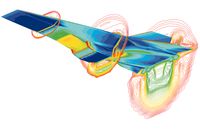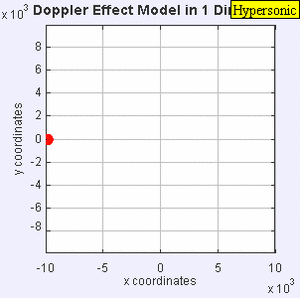سرعة فرط صوتية
في الديناميكا الهوائية، السرعة الفرط صوتية hypersonic speed، هي السرعة الأعلى من الأسرع من الصوت. منذ السبعينيات، استخدم المصطلح للإشارة إلى السرعات 5 ماخ وما فوقها.
رقم ماخ الدقيق والذي عنده يمكن القول أن المركبة تطير بسرعات فرط صوتية، حيث أن التغيرات الفيزيائية الفردية في تدفق الهواء (مثل التفكك والتأين الجزيئي) تحدث بسرعات مختلفة؛ فإن هذه الآثار المجمعة تصبح ذات أهمية حول ماخ 5-10. التعريف البديل للنظام الفرط صوتي هي السرعات التي لا تنتج عندها النفاثات التضاغطية دفعاً صافياً.[1]
خصائص التدفق
While the definition of hypersonic flow can be quite vague and is generally debatable (especially due to the absence of discontinuity between supersonic and hypersonic flows), a hypersonic flow may be characterized by certain physical phenomena that can no longer be analytically discounted as in supersonic flow.[بحاجة لمصدر] تتميز السرعات الفرط صوتية بالخصائص التالية:
- طبقة الصدمة
- تسخين حركي هوائي
- طبقة الأنتروپيا
- آثار الغاز الحقيقي
- آثار الكثافة المنخصة
- استقلال المعاملات الديناميكية الهوائية عن رقم الماخ
Small shock stand-off distance
As a body's Mach number increases, the density behind a bow shock generated by the body also increases, which corresponds to a decrease in volume behind the shock due to conservation of mass. Consequently, the distance between the bow shock and the body decreases at higher Mach numbers.[بحاجة لمصدر]
طبقة الإنتروپية
As Mach numbers increase, the entropy change across the shock also increases, which results in a strong entropy gradient and highly vortical flow that mixes with the boundary layer.
التفاعل اللزج
A portion of the large kinetic energy associated with flow at high Mach numbers transforms into internal energy in the fluid due to viscous effects. The increase in internal energy is realized as an increase in temperature. Since the pressure gradient normal to the flow within a boundary layer is approximately zero for low to moderate hypersonic Mach numbers, the increase of temperature through the boundary layer coincides with a decrease in density. This causes the bottom of the boundary layer to expand, so that the boundary layer over the body grows thicker and can often merge with the shock wave near the body leading edge.[بحاجة لمصدر]
تدفق عالي الحرارة
High temperatures due to a manifestation of viscous dissipation cause non-equilibrium chemical flow properties such as vibrational excitation and dissociation and ionization of molecules resulting in convective and radiative heat-flux.[بحاجة لمصدر]
تصنيف أنظمة ماخ
Although "subsonic" and "supersonic" usually refer to speeds below and above the local speed of sound respectively, aerodynamicists often use these terms to refer to particular ranges of Mach values. This occurs because a "transonic regime" exists around M=1 where approximations of the Navier–Stokes equations used for subsonic design no longer apply, partly because the flow locally exceeds M=1 even when the freestream[مطلوب توضيح] Mach number is below this value.[مطلوب توضيح]
The "supersonic regime" usually refers to the set of Mach numbers for which linearised theory may be used; for example, where the (air) flow is not chemically reacting and where heat transfer between air and vehicle may be reasonably neglected in calculations. Generally, NASA defines "high" hypersonic as any Mach number from 10 to 25, and re-entry speeds as anything greater than Mach 25. Among the spacecraft operating in these regimes are returning Soyuz and Dragon space capsules; the previously-operated Space Shuttle; various reusable spacecraft in development such as SpaceX Starship and Rocket Lab Electron; as well as (theoretical) spaceplanes.[بحاجة لمصدر]
In the following table, the "regimes" or "ranges of Mach values" are referenced instead of the usual meanings of "subsonic" and "supersonic".[بحاجة لمصدر]
| النظام | (رقم ماخ) | (ميل/س) | (كم/س) | (م/ث) | الخصائص العامة للطائرة |
|---|---|---|---|---|---|
| دون سرعة الصوت | <0.8 | <614 | <988 | <274 | Most often propeller-driven and commercial turbofan aircraft with high aspect-ratio (slender) wings, and rounded features like the nose and leading edges. |
| قريبة أو عند سرعة الصوت | 0.8–1.2 | 614–921 | 988–1,482 | 274–412 | Transonic aircraft nearly always have swept wings that delay drag-divergence, and often feature designs adhering to the principles of the Whitcomb area rule. |
| أسرع من الصوت | 1.2–5.0 | 921–3,836 | 1,482–6,174 | 412–1,715 | Aircraft designed to fly at supersonic speeds show large differences in their aerodynamic design because of the radical differences in the behaviour of fluid flows above Mach 1. Sharp edges, thin airfoil-sections, and all-moving tailplane/canards are common. Modern combat aircraft must compromise in order to maintain low-speed handling; "true" supersonic designs include the F-104 Starfighter and BAC/Aérospatiale Concorde. |
| فرط صوتية | 5.0–10.0 | 3,836–7,673 | 6,174–12,348 | 1,715–3,430 | Cooled nickel or titanium skin; highly integrated (due to domination of interference effects: non-linear behaviour means that superposition of results for separate components is invalid)[مطلوب توضيح], small wings, see X-51A Waverider, HyperSoar and WU-14 (DF-ZF). |
| فرط صوتية-مرتفعة | 10.0–25.0 | 7,673–19,182 | 12,348–30,870 | 3,430–8,575 | Thermal control becomes a dominant design consideration. Structure must either be designed to operate hot, or be protected by special silicate tiles or similar. Chemically reacting flow can also cause corrosion of the vehicle's skin, with free-atomic oxygen featuring in very high-speed flows. Examples include the 53T6 ABM-3 Gazelle (Mach 17) anti-ballistic missile and DF-41 (Mach 25) intercontinental ballistic missile. Hypersonic designs are often forced into blunt configurations because of the aerodynamic heating rising with a reduced radius of curvature. |
| سرعات معاودة الدخول |
>25.0 | >19,181.7 | >30,869.95 | >8,575 | Ablative heat shield; small or no wings; blunt shape. |
متغيرات التشابه
The categorization of airflow relies on a number of similarity parameters, which allow the simplification of a nearly infinite number of test cases into groups of similarity. For transonic and compressible flow, the Mach and Reynolds numbers alone allow good categorization of many flow cases.[بحاجة لمصدر]
Hypersonic flows, however, require other similarity parameters. First, the analytic equations for the oblique shock angle become nearly independent of Mach number at high (~>10) Mach numbers. Second, the formation of strong shocks around aerodynamic bodies means that the freestream Reynolds number is less useful as an estimate of the behavior of the boundary layer over a body (although it is still important). Finally, the increased temperature of hypersonic flow mean that real gas effects become important. Research in hypersonics is therefore often called aerothermodynamics, rather than aerodynamics.[2]
The introduction of real gas effects means that more variables are required to describe the full state of a gas. Whereas a stationary gas can be described by three variables (pressure, temperature, adiabatic index), and a moving gas by four (flow velocity), a hot gas in chemical equilibrium also requires state equations for the chemical components of the gas, and a gas in nonequilibrium solves those state equations using time as an extra variable. This means that for nonequilibrium flow, something between 10 and 100 variables may be required to describe the state of the gas at any given time. Additionally, rarefied hypersonic flows (usually defined as those with a Knudsen number above 0.1) do not follow the Navier–Stokes equations.[بحاجة لمصدر]
Hypersonic flows are typically categorized by their total energy, expressed as total enthalpy (MJ/kg), total pressure (kPa-MPa), stagnation pressure (kPa-MPa), stagnation temperature (K), or flow velocity (km/s).[بحاجة لمصدر]
Wallace D. Hayes developed a similarity parameter, similar to the Whitcomb area rule, which allowed similar configurations to be compared.[بحاجة لمصدر]
الأنظمة
Hypersonic flow can be approximately separated into a number of regimes. The selection of these regimes is rough, due to the blurring of the boundaries where a particular effect can be found.[بحاجة لمصدر]
الغاز المثالي
In this regime, the gas can be regarded as an ideal gas. Flow in this regime is still Mach number dependent. Simulations start to depend on the use of a constant-temperature wall, rather than the adiabatic wall typically used at lower speeds. The lower border of this region is around Mach 5, where ramjets become inefficient, and the upper border around Mach 10-12.[بحاجة لمصدر]
الغاز المثالي بدرجتي حرارة
This is a subset of the perfect gas regime, where the gas can be considered chemically perfect, but the rotational and vibrational temperatures of the gas must be considered separately, leading to two temperature models. See particularly the modeling of supersonic nozzles, where vibrational freezing becomes important.[بحاجة لمصدر]
الغاز المتفكك
In this regime, diatomic or polyatomic gases (the gases found in most atmospheres) begin to dissociate as they come into contact with the bow shock generated by the body. Surface catalysis plays a role in the calculation of surface heating, meaning that the type of surface material also has an effect on the flow. The lower border of this regime is where any component of a gas mixture first begins to dissociate in the stagnation point of a flow (which for nitrogen is around 2000 K). At the upper border of this regime, the effects of ionization start to have an effect on the flow.[بحاجة لمصدر]
الغاز المؤين
In this regime the ionized electron population of the stagnated flow becomes significant, and the electrons must be modeled separately. Often the electron temperature is handled separately from the temperature of the remaining gas components. This region occurs for freestream flow velocities around 3-4 km/s. Gases in this region are modeled as non-radiating plasmas.[بحاجة لمصدر]
النظام المحكوم بالإشعاع
Above around 12 km/s, the heat transfer to a vehicle changes from being conductively dominated to radiatively dominated. The modeling of gases in this regime is split into two classes:[بحاجة لمصدر]
- Optically thin: where the gas does not re-absorb radiation emitted from other parts of the gas
- Optically thick: where the radiation must be considered a separate source of energy.
The modeling of optically thick gases is extremely difficult, since, due to the calculation of the radiation at each point, the computation load theoretically expands exponentially as the number of points considered increases.
انظر أيضاً
- نقل أسرع من الصوت
- رفع الجسم
- دخول الغلاف الجوي
- رحلة فرط صوتية
- مشروع دارپا فالكون
- Reaction Engines Skylon (دراسة تصميم)
- Reaction Engines A2 (دراسة تصميم)
- HyperSoar (مفهوم)
- X-51 A Waverider
- X-20 Dyna-Soar (ملغاة)
- Rockwell X-30 (ملغاة)
- أڤاتار RLV
- Hypersonic Technology Demonstrator Vehicle
- Ayaks
- المركبة الشراعية الفرط صوتية وو-14 (قيد التطوير)
- Lockheed Martin SR-72 (مزمعة)
- محركات
- محرك صاروخي
- محرك نفاث تضاغطي
- محرك نفاث فرطي
- Reaction Engines SABRE, LAPCAT (دراسات تصميم)
- صواريخ
- الصاروخ البالستي شوريا -
 الهند (دخل الانتاج)
الهند (دخل الانتاج) - الصاروخ الجوال BrahMos-II -
 الهند (قيد التطوير)
الهند (قيد التطوير) - الصاروخ البالستي قصير المدى إسكندر 9ك720
 روسيا (في الخدمة حالياً)
روسيا (في الخدمة حالياً)
- أنظمة تدفق أخرى
المصادر
- Anderson, John (2006). Hypersonic and High-Temperature Gas Dynamics Second Edition. AIAA Education Series. ISBN 1-56347-780-7.
وصلات خارجية
- NASA's Guide to Hypersonics
- Hypersonics Group at Imperial College
- University of Queensland Centre for Hypersonics
- High Speed Flow Group at University of New South Wales
- Hypersonics Group at the University of Oxford
- ^ "Specific Heat Capacity, Calorically Imperfect Gas". Glenn Research Center. NASA. Retrieved 2019-12-27.
- ^ Anderson, John (2006). Hypersonic and High-Temperature Gas Dynamics (Second ed.). AIAA Education Series. ISBN 1-56347-780-7.
- Short description is different from Wikidata
- Articles with hatnote templates targeting a nonexistent page
- مقالات ذات عبارات بحاجة لمصادر
- جميع الصفحات التي تحتاج تنظيف
- مقالات بالمعرفة تحتاج توضيح from March 2018
- مقالات بالمعرفة تحتاج توضيح from June 2021
- ديناميكا هوائية
- هندسة الطيران
- سرعة الهواء
- دفع المركبات الفضائية

